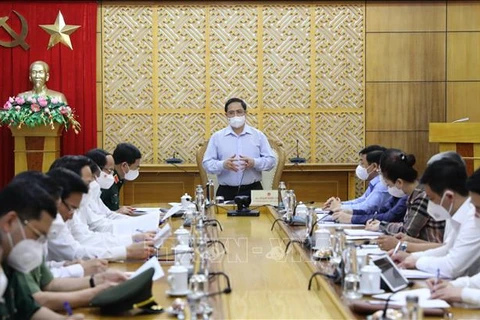 A medical worker collects samples for COVID-19 testing in Hien Thanh ward of Kinh Mon town, Hai Duong province. (Photo: VNA)
A medical worker collects samples for COVID-19 testing in Hien Thanh ward of Kinh Mon town, Hai Duong province. (Photo: VNA) Hanoi (VNA) – Vietnam is confronted with unpredictable developments of the COVID-19 pandemic in the fourth wave of infections. It has recorded more than 3,000 infection cases caused by new variants over the past month.
The number of cases has been rising sharply over the last few days, especially in such hot spots as Bac Giang and Bac Ninh provinces.
Talking about coronavirus variants, Professor Phan Trong Lan, Director of the Pasteur Institute in Ho Chi Minh City, said during transmission, viruses in general and SARS-CoV-2 in particular may have changes in their genetic structures after replicating and multiplying for many times.
When the transmission process accelerates, viral replication and multiplication will also increase, creating more chances for genetic mutations to appear and subsequently raising the probability of variants.
More than 28,000 genetic mutations of the coronavirus SARS-CoV-2 have been reported around the world. Most of them do not change the characteristics of this virus, but some can affect its biological characteristics such as increasing the transmissibility, helping the virus to evade the immune system, and boosting its capacity to enter respiratory epithelial cells, according to the expert.
 Professor Phan Trong Lan, Director of the Pasteur Institute in Ho Chi Minh City. (Photo: VietnamPlus)
Professor Phan Trong Lan, Director of the Pasteur Institute in Ho Chi Minh City. (Photo: VietnamPlus) The World Health Organisation (WHO) divided SARS-CoV-2 variants into two groups: variants of interest (VOIs) and variants of concern (VOCs).
The VOCs include B.1.1.7 (first detected in the UK) that has been reported in 155 countries, B.1.351 (in South Africa) recorded in 111 countries, P.1 (in Brazil) in 62 countries, and B.1.617 (in India) in 61 countries.
In Vietnam, since the pandemic broke out, variants carrying the D614G mutation were first found on some workers returning from abroad in early March 2020. After that, the presence of VOCs was confirmed such as B.1.1.7 and B.1.351 that were first recorded on the citizens returning from the UK in October 2020, and now B.1.617 in the clusters in Yen Bai and Ha Nam provinces.
After a period of time since their first appearance, VOCs have spread to most of countries around the world, including Vietnam, requiring higher levels of pandemic prevention and control, Lan noted.
He held that to prevent and control infectious respiratory diseases, it is necessary to focus on three factors: sources of transmission, modes of transmission, and persons exposed to the virus.
To protect people by vaccination, the Government and the Ministry of Health are exerting all-out efforts to secure vaccine for people and will mobilise the vaccination system to administer vaccine to those prioritised for inoculation. Early and full vaccination in line with the Health Ministry’s guidance is needed to secure full immunity.
Lan said large vaccine coverage will not only protect individuals from severe illness or reduce the fatality rate but also reduce the transmission of SARS-CoV-2 and help prevent the appearance of new variants.
So far, Vietnam has strictly managed people entering the country via official channels, but if it fails to control illegal entries or people who just transit the country, it will be hard to trace sources of transmission.
The negligence of pandemic prevention rules at concentrated quarantine sites or home quarantine could lead to new infections, he warned, pointing out that about 60 percent of cases neither show any symptoms nor know they have contracted the virus, which can fuel the spread of this disease.
Thought existing variants are highly contagious, quarantine is still the most effective measure to curb the transmission of SARS-CoV-2. Quarantine could be practiced by wearing face masks, keeping physical distance, carrying out health quarantine, and imposing social distancing.
Professor Lan called on each people to be fully aware of the importance of steering clear of high-risk behaviours and seriously comply with the 5K principle (khau trang - wearing facemasks, khu khuan - disinfection, khoang cach - keeping distance, khong tu tap - no gathering, and khai bao y te - making health declaration)./.


























